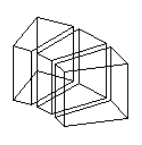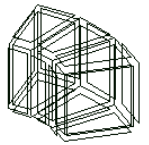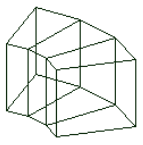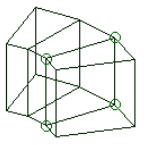Faces Panel
Use the Faces panel to find the free faces in a group of elements, and operates in the same manner as edges, but in 3D. It also allows you to find and delete duplicate nodes.
This function will find free faces in your model where elements are separated, and highlight those areas. Once the free faces are located, you can use equivalence to remove the duplicate nodes, based on a tolerance specified by you. The preview option is available to allow you to see which nodes will be equivalenced.
Location: Tool page
Finding Faces
The free faces that are found are displayed as quad or tria elements. All of the elements created during a find are placed into a component called ^faces which is created by the find faces command.
To avoid confusion, ^faces is deleted (if it exists) and then re-created at the beginning of the find faces function.
The elements that were selected before the find faces function remain selected upon completion of the function.
 Figure 1. Entities Selected |
 Figure 2. Free Faces of the Selected Group of Entities are Highlighted |
 Figure 3. Entities Selected |
 Figure 4. Duplicate Nodes Displayed |
Deleting Faces
The delete faces functionality does not affect selected data. The elements or components that were previously selected remain selected upon completion of this function.
This function can also be performed in the Delete panel by deleting the component, ^faces.
Panel Options
| Option | Action |
|---|---|
| entity selector | Select the type of entity that you wish to pick. |
| tolerance | Specify the minimum coordinate distance between two nodes. In other words, a three-dimensional cube with sides equal to the length of tolerance around each node in the model is constructed. If a second node lies within the cube formed, it is considered duplicate to the first and is displayed |
| equiv at | Specify where to
resolve a group of coincident nodes (that is, where the
resulting single node lies):
|
| retain | When nodes are equivalenced, the resolved node will retain the
node ID of either the lowest ID in the group, or the highest ID
in the group, depending on what you pick from this toggle. Note: When equivalencing at the midpoint, the
node will still be moved.
|
Command Buttons
| Button | Action |
|---|---|
| find faces | Highlight the free faces of the selected group of entities. |
| delete faces | Delete the component ^faces. |
| preview equiv | Display duplicate nodes. |
| reject | Reject the changes made. |
| return | Exit the panel. |